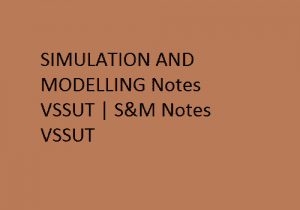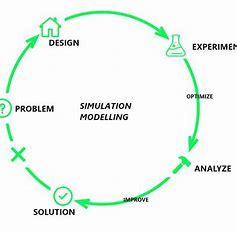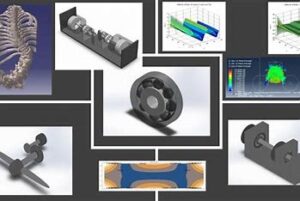SIMULATION AND MODELLING Notes PDF VSSUT – SM Notes PDF VSSUT of Total Complete Notes
Please find the download links of SIMULATION AND MODELLING PDF VSSUT | SM PDF VSSUT are listed below:
Link: Complete Notes
Link: Module – 1
Link: Module – 2
Link: Module – 3
Link: Module – 4
Simulation and Modelling Notes Pdf – VSSUT SM Notes – B. Tech Notes 2025
Welcome to your ultimate resource for Simulation and Modelling notes designed for B. Tech students. If you’re seeking comprehensive lecture notes to enhance your understanding of Simulation and Modelling, you’re in the right place. Below, you’ll find detailed descriptions, download links, and benefits of the Simulation and Modelling notes from Veer Surendra Sai University of Technology (VSSUT).
Description
The Simulation and Modelling subject involves understanding and applying various simulation techniques to model complex systems. This course is crucial for students aiming to develop skills in analyzing and designing simulations for diverse applications. The notes provided here cover a wide range of topics essential for mastering the subject, including system environments, simulation methods, discrete and continuous system simulation, and the use of simulation languages.
These notes are meticulously organized to help students grasp the concepts thoroughly, making them an excellent resource for both exam preparation and practical applications.
Overview: SM Notes Pdf
Our Simulation and Modelling Notes Pdf offers a structured learning approach. The notes are divided into four detailed modules, each covering critical aspects of the subject. This structured format ensures that you can easily follow and understand complex simulation concepts and techniques.
The following topics are covered in Simulation and Modelling handwritten Notes
Module 1:
- Prerequisites: Understanding Linear Algebra, Probability, and Statistics
- System Environment: Exogenous and Endogenous Systems
- Types of Systems: Deterministic vs. Stochastic Systems
- Models and Principles: Principles used in Modelling
- Simulation Definitions: Definition and Application Areas of Simulation
- Monte-Carlo Technique: Introduction to Monte-Carlo Simulation
- Comparison Methods: Simulation vs. Analytical Methods
- Numerical Computation: Techniques for Discrete Structures, Graph Theory
- Design and Programming: Object-Oriented Design and Programming
Module 2:
- Inventory Concept: Techniques and Major Application Areas
- System Concepts: Continuous and Discrete Systems, Types of Models
- Simulation Study Progress: Steps in a Simulation Study
- Monte Carlo Method: Detailed Analysis
- Comparison: Simulation vs. Analytical Methods
- Numerical Computation Techniques: For Discrete and Continuous Models
- Continuous System Simulation: Detailed Approaches
Module 3:
- Discrete System Simulation and GPSS:
- Discrete Events: Representation of Time
- Arrival Patterns: Generation and Simulation
- Fixed Time Step vs. Next Event Simulation
- GPSS Introduction: Creating and Managing Transactions, Queues, Facilities, and Storages
- Statistics Gathering: Conditional Transfers, Program Control Statements
- Priority and Parameters: Standard Numerical Attributes, Functions, Gates, Logic Switches
- Variables and Testing: Select and Count
Module 4:
- Simulation Languages and Practical Systems:
- Languages for Continuous and Discrete Systems: Factors in Choosing Simulation Languages
- Computer Models: Queuing, Inventory, and Scheduling Systems
- Design and Evaluation of Experiments: Length of Simulation Runs, Validation
- Variance Reduction Techniques: Experimental Layout, Analysis of Simulation Output
- Recent Trends: Developments in Simulation and Modelling
Links to Download SM Notes Pdf
You can access the complete set of Simulation and Modelling Notes Pdf through the following links:
SM Notes and Study Material PDF Free Download
The Simulation and Modelling Notes are available for free download, providing you with a complete set of study materials necessary for mastering the subject. These notes are designed to ensure you have access to all the essential content needed for effective learning and exam preparation.
Topics Covered in this SM Notes Pdf
- Overview of system environments and types
- Detailed discussion on various simulation techniques and methods
- In-depth coverage of Monte Carlo methods and their applications
- Simulation of both discrete and continuous systems
- Use of GPSS for discrete system simulation
- Selection of simulation languages and practical system modeling
- Design and evaluation of simulation experiments
SM Notes Pdf from VSSUT
The Simulation and Modelling Notes from VSSUT are specifically tailored for B. Tech students, covering the entire syllabus in detail. These notes are created by expert faculty members to ensure that they are accurate and comprehensive. They are ideal for studying, revising, and preparing for exams.
Always Choose Smartzworld to Download SM Notes PDF
Smartzworld is your reliable source for downloading high-quality B. Tech notes. We offer free and easy access to well-organized notes and study materials, ensuring you receive accurate and up-to-date content for your studies.
Benefits of FREE SM Handwritten Notes PDF
- Comprehensive Coverage: Detailed notes on all modules of the Simulation and Modelling syllabus.
- High-Quality Content: Prepared by experienced faculty with a focus on clarity and comprehensiveness.
- Easy to Understand: Includes explanations, examples, and diagrams for better understanding.
- Exam Preparation: Perfect for revision and preparation.
- Free Access: Download without any cost.
- Convenient Format: Available in PDF for easy access on any device.
FAQs
Q1. Where can I download the Simulation and Modelling Notes Pdf?
You can download the notes from the provided links for each module or the complete set from Smartzworld.
Q2. How to download the SM Notes Pdf?
Click on the respective module links or the complete notes link to download the SM Notes Pdf.
Q3. How many modules are covered in SM Notes Pdf?
The SM Notes Pdf covers four modules, each focusing on different aspects of Simulation and Modelling.
Q4. Topics Covered in SM Notes Pdf?
The topics include system environments, simulation techniques, Monte Carlo methods, GPSS, simulation languages, and practical systems.
Q5. Where can I get the complete SM Handwritten Notes pdf FREE Download?
The complete SM handwritten notes can be downloaded from the provided links.
Q6. How to download SM Handwritten Notes pdf?
Click on the download links for each module or the complete set to access the SM handwritten notes pdf.
Q7. How to Download FREE SM Notes PDF?
You can download the FREE SM Notes PDF by following the download links for the modules or the complete set.
Text Books:
1. Geoffrey Gordon, System Simulation,2/E, PHI Learning.
2. Narsingh Deo, System Simulation with Digital Computer, 2007, PHI Learning.
References:
1. Jerry Banks, John S. Carson II, Barry L. Nelson, David M. Nicol, P. Shahabudeen,
Discrete-Event System Simulation, Fourth Edition, Pearson Publication.



